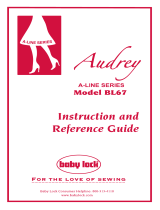
TO MAKE PIPING:
1. Attach the Piping Foot.
2. Cut fabric strips (bias or on-grain) wide enough to
cover the cording plus seam allowances.
3. Wrap the fabric over the cord.
4. Place the fabric and cord under the foot aligning the
cord in the groove on the underside of the foot.
5. Adjust your needle so the needle drops right next to
the cord. Sew. The grooves will guide the cord so the
fabric covers it evenly.
TO STITCH PIPING INTO A SEAM:
1. Attach the Piping Foot.
2. Align the piping along the seam line on the right side
of the fabric. Place the second piece of fabric on top
with the right sides together.
3. Start by placing your needle in the left position and
move the needle to the right using the width control.
4. Stitch in place. The piping will guide through the
groove on the underside of the foot.
Piping Foot - Left
(BLSO-LP)
Instructions
Baby Lock
Sewing Accessories
Piping can be made for finishing detail on projects ranging
from home decorating to the finest heirloom garments. This
piping foot accommodates a 2mm piping cord. The clear view
allows you to see exactly where you are stitching for perfect
placement. The left position groove and markings on the foot
allows for piping cord to be properly placed for a 3/8” seam
allowance.
MACHINE SETTINGS:
Stitch: Straight Stitch
Stitch length: 2.5
Stitch width: Adjust width setting to achieve
needle position desired
Piping cord: 2mm
LNIS-BLSOLP
800-422-2952 www.babylock.com
Note:
• When inserting pre-made piping into a garment,
adjust the needle position so it stitches one setting
closer to the cord, to cover the rst row of stitching.
• Adding notches into the seam allowance of pre-made
piping will allow for turning in tight curves and
corners.



